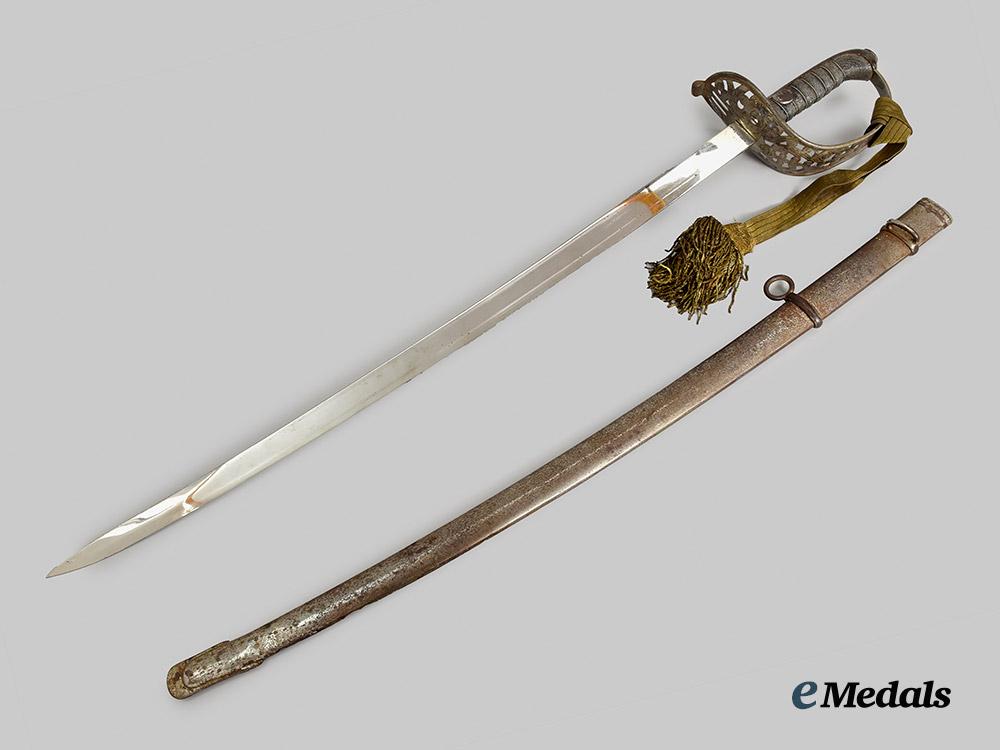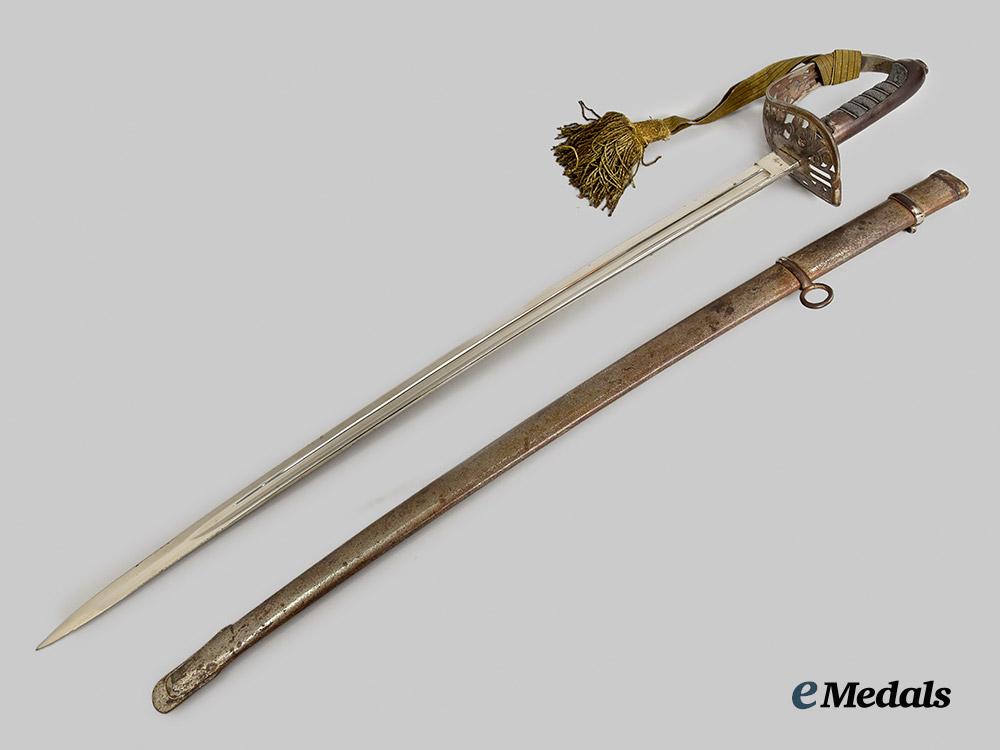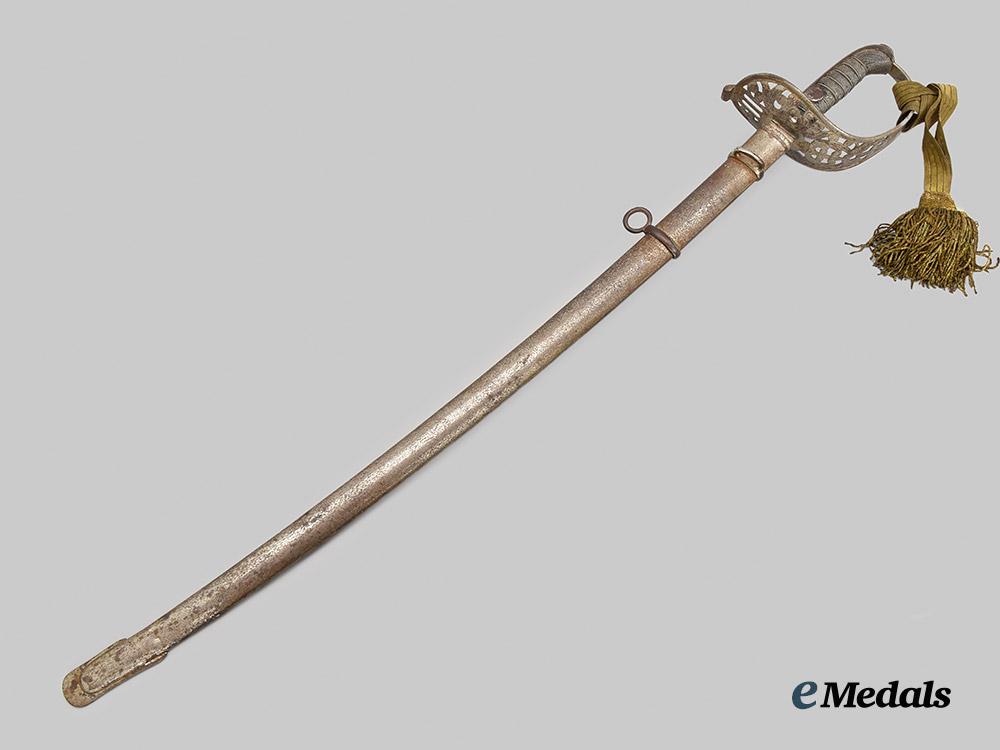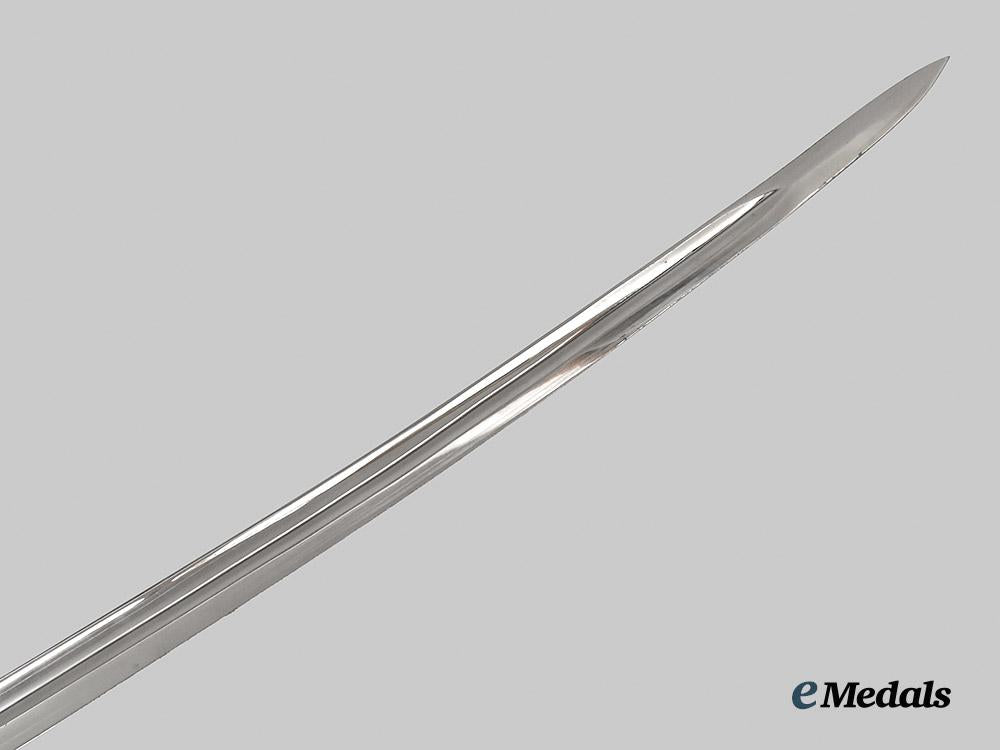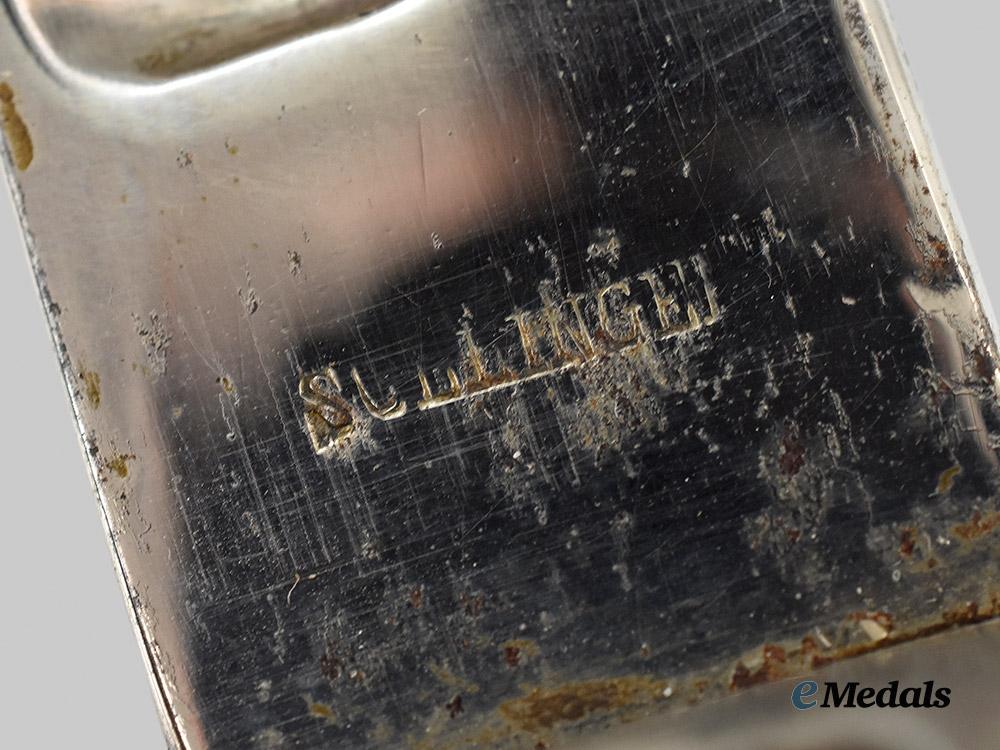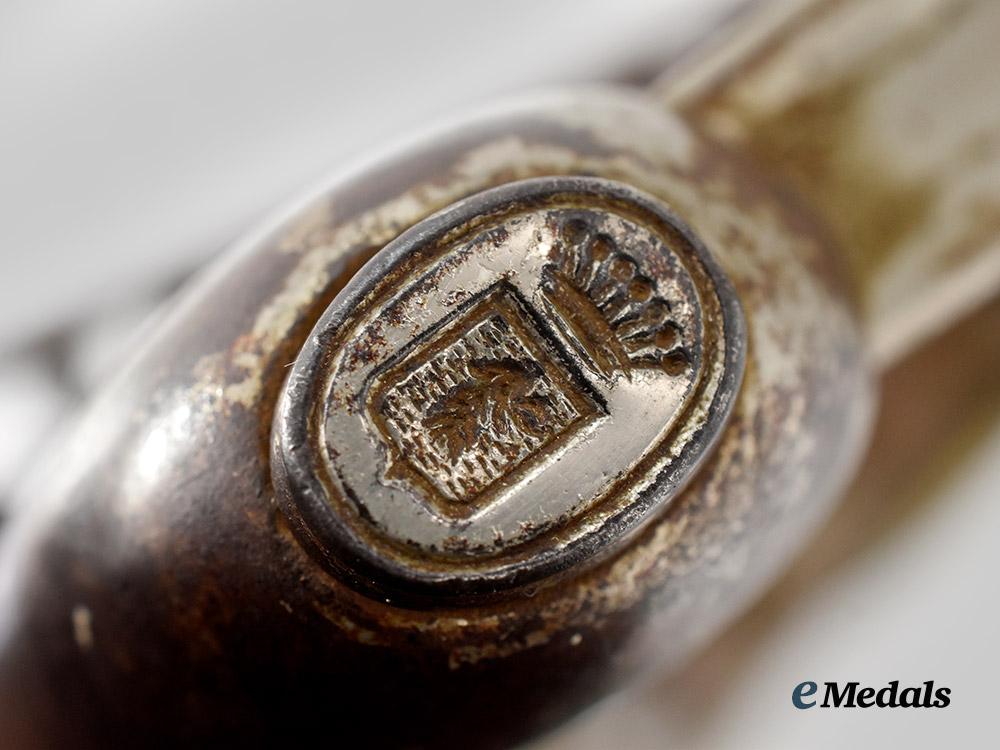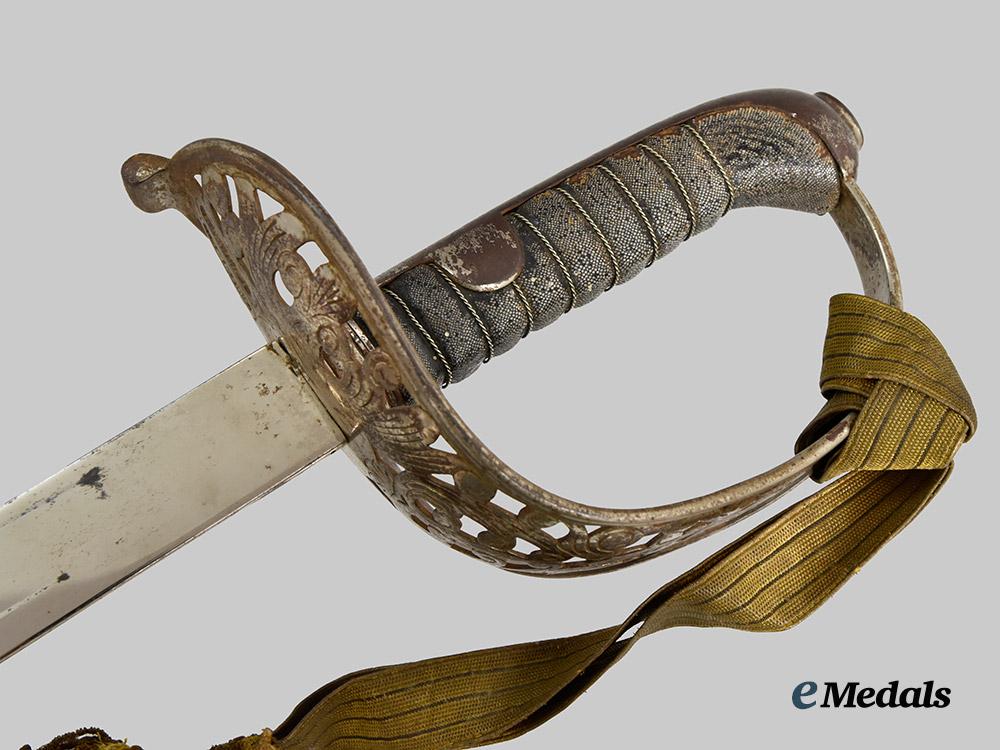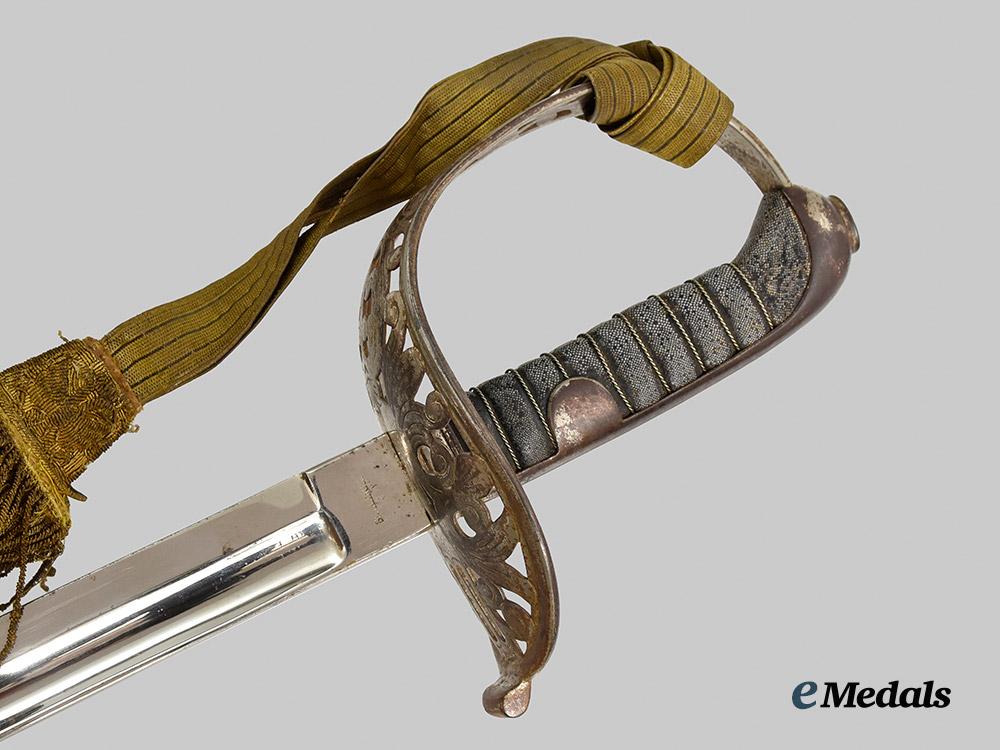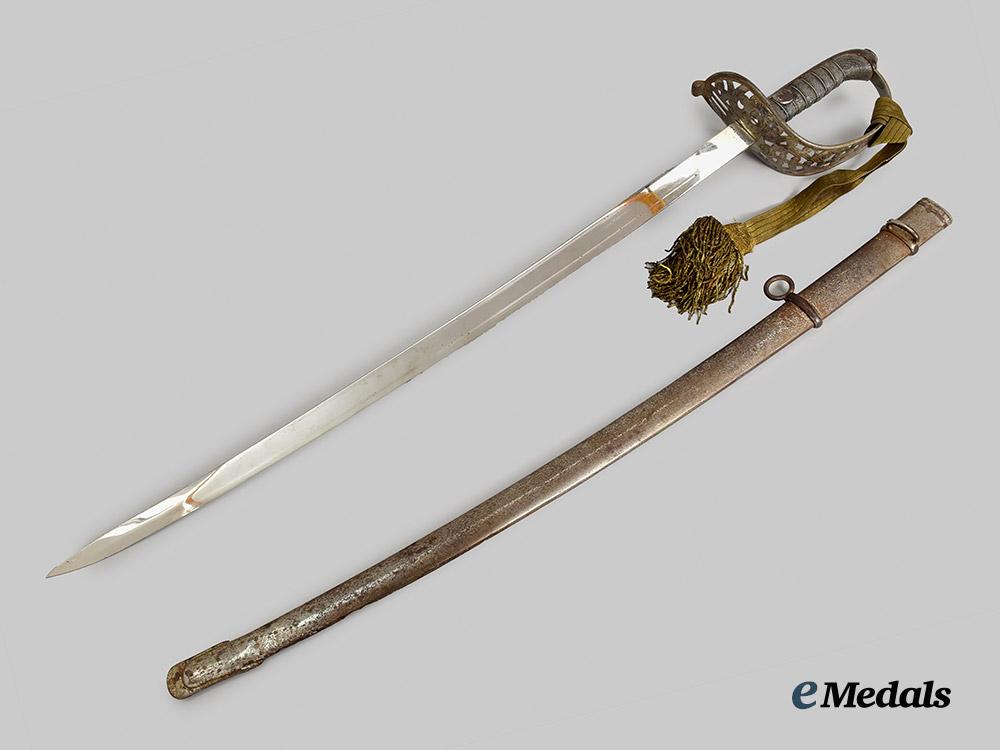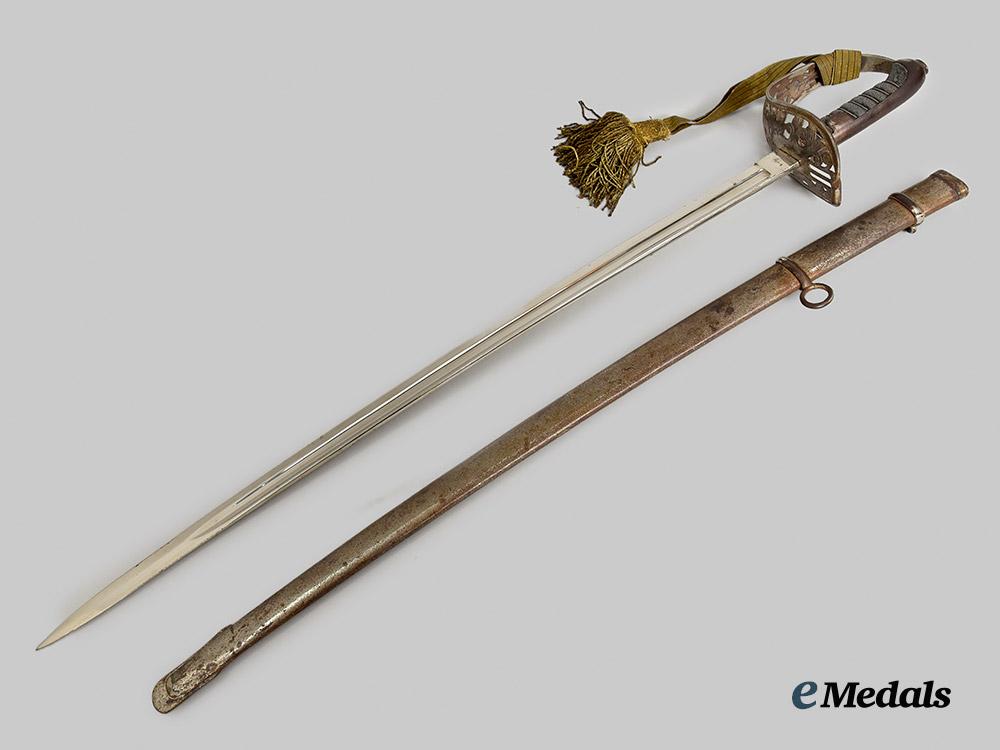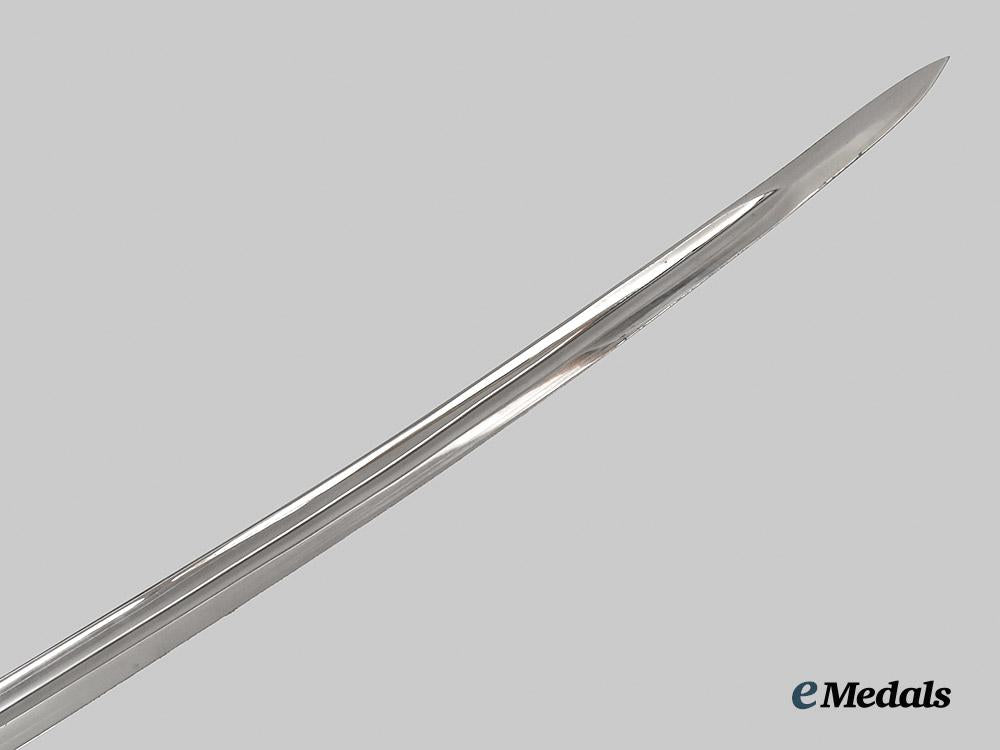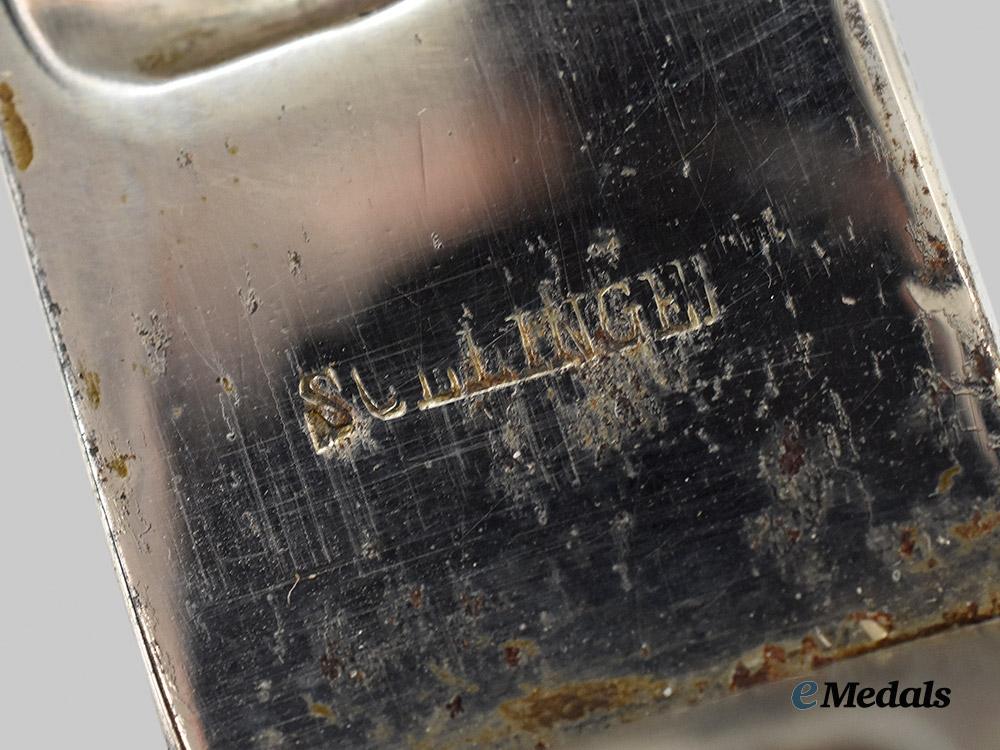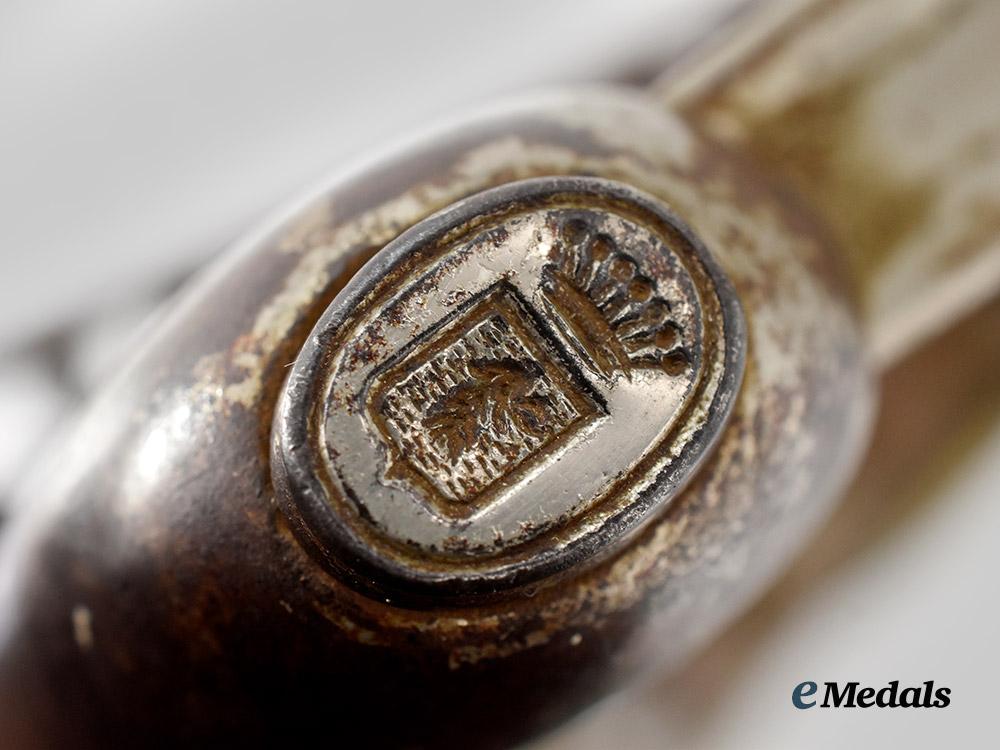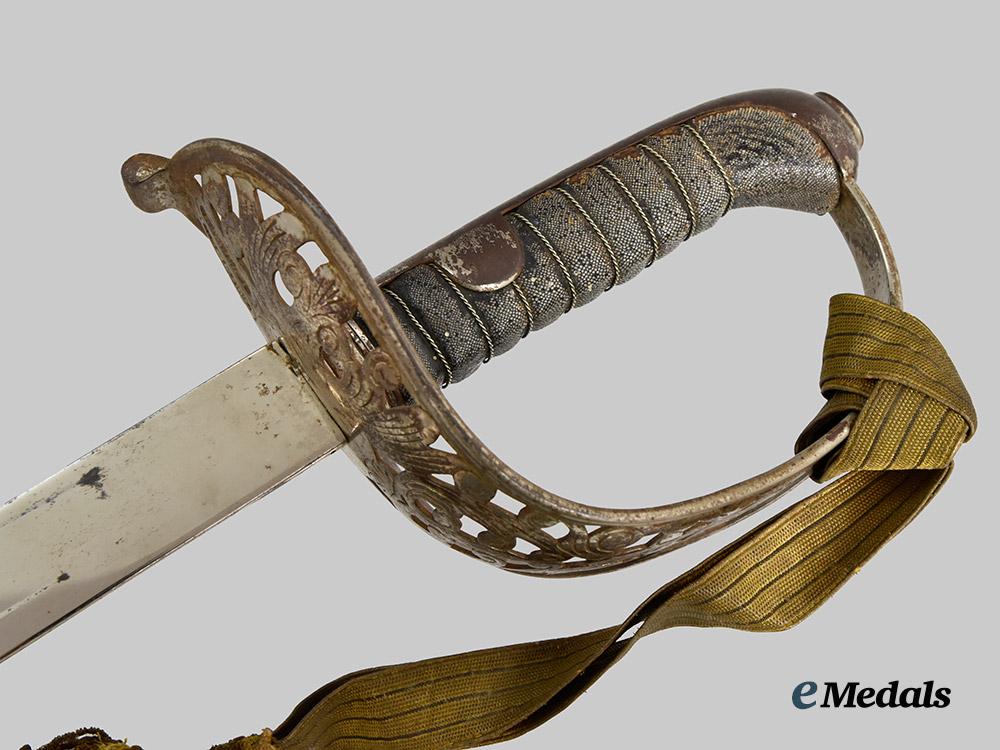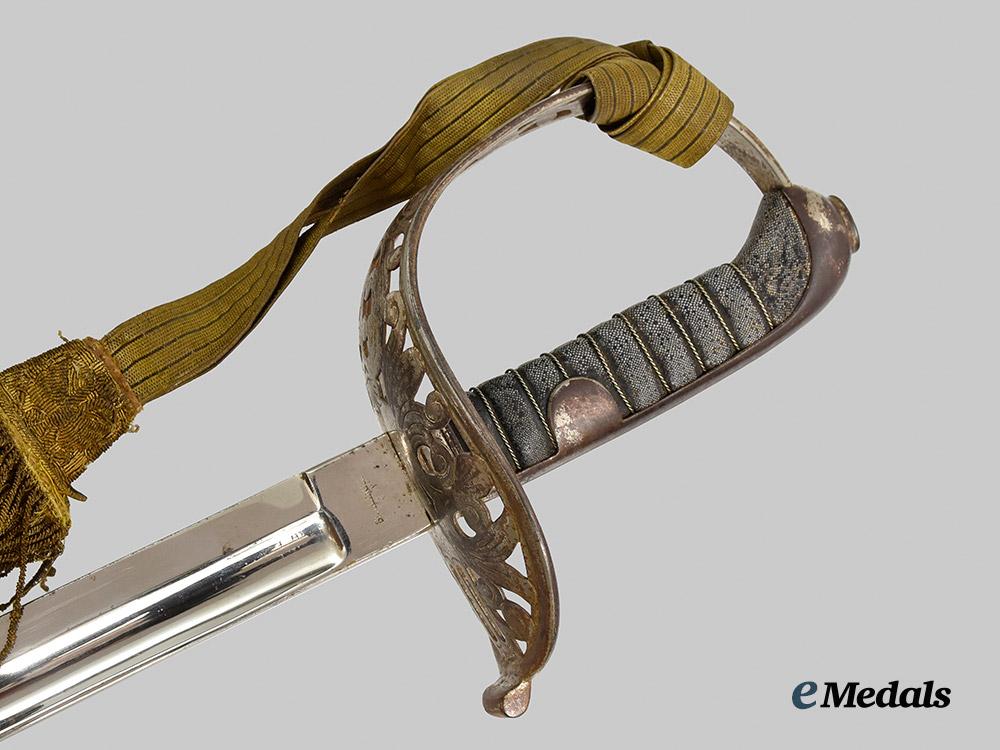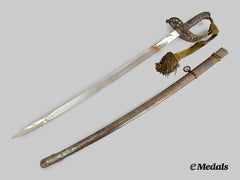
LOADING ...
In response to evolving domestic opinion, eMedals Inc has made the conscious decision to remove the presentation of German Third Reich historical artifacts from our online catalogue. For three decades, eMedals Inc has made an effort to preserve history in all its forms. As historians and researchers, we have managed sensitive articles and materials with the greatest of care and respect for their past and present social context. We acknowledge the growing sentiments put forth by the Canadian public and have taken proactive actions to address this opinion.
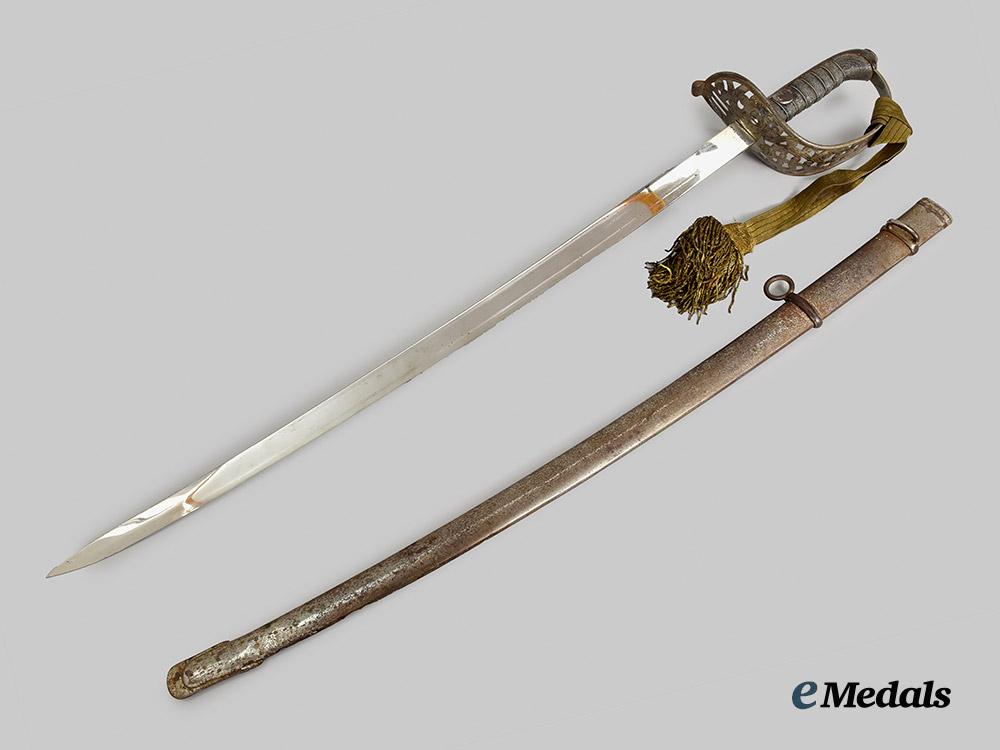
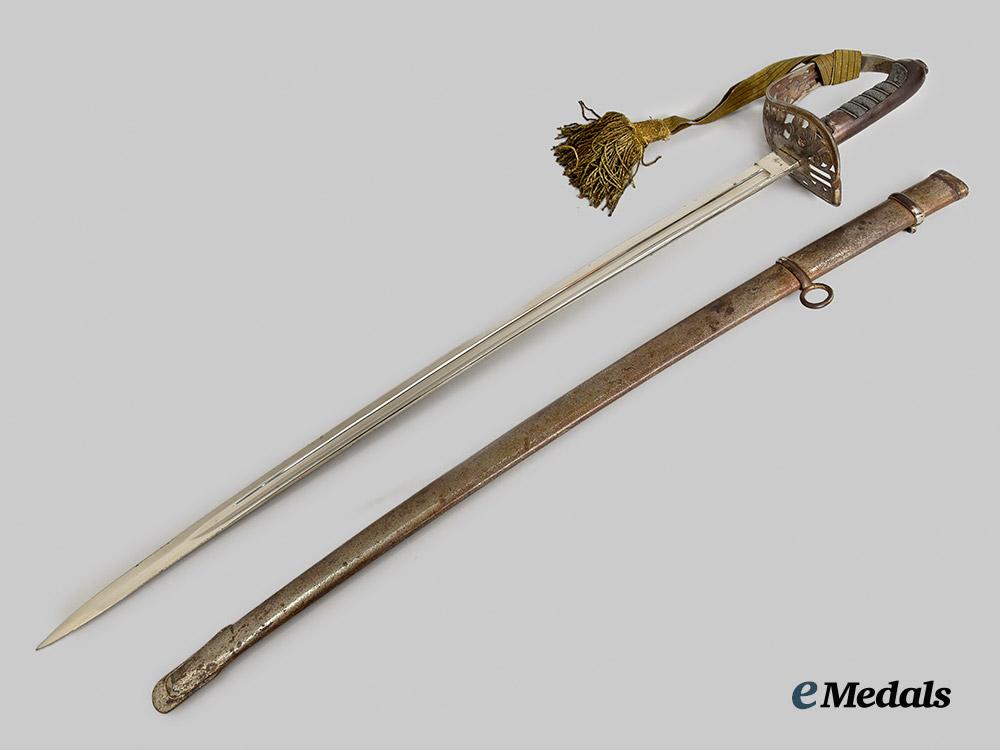
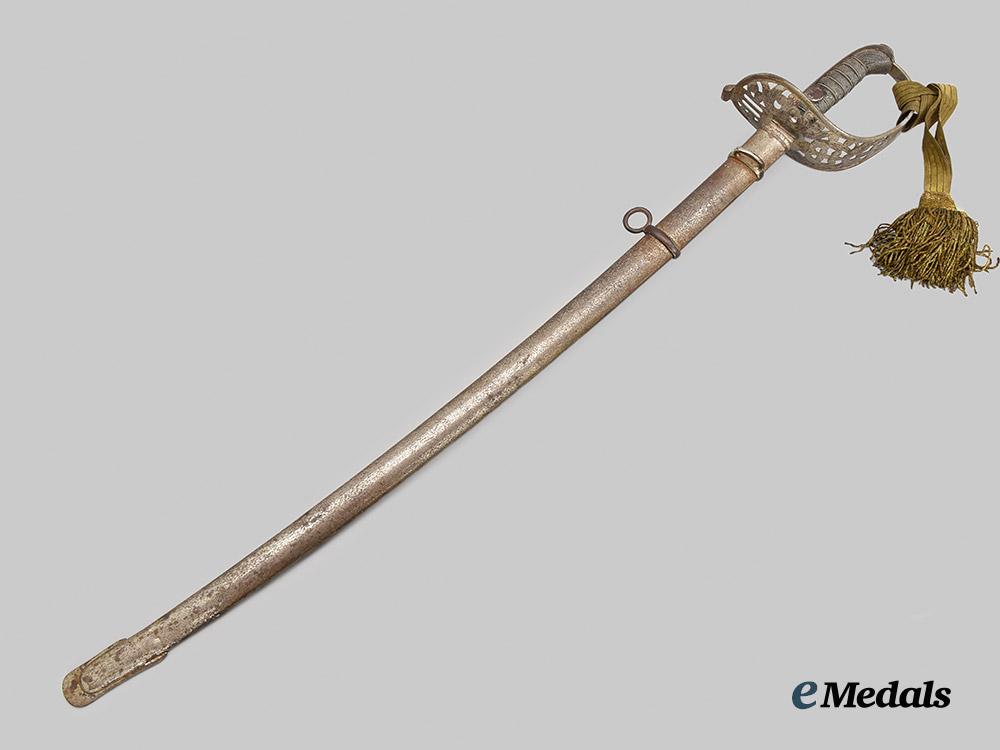
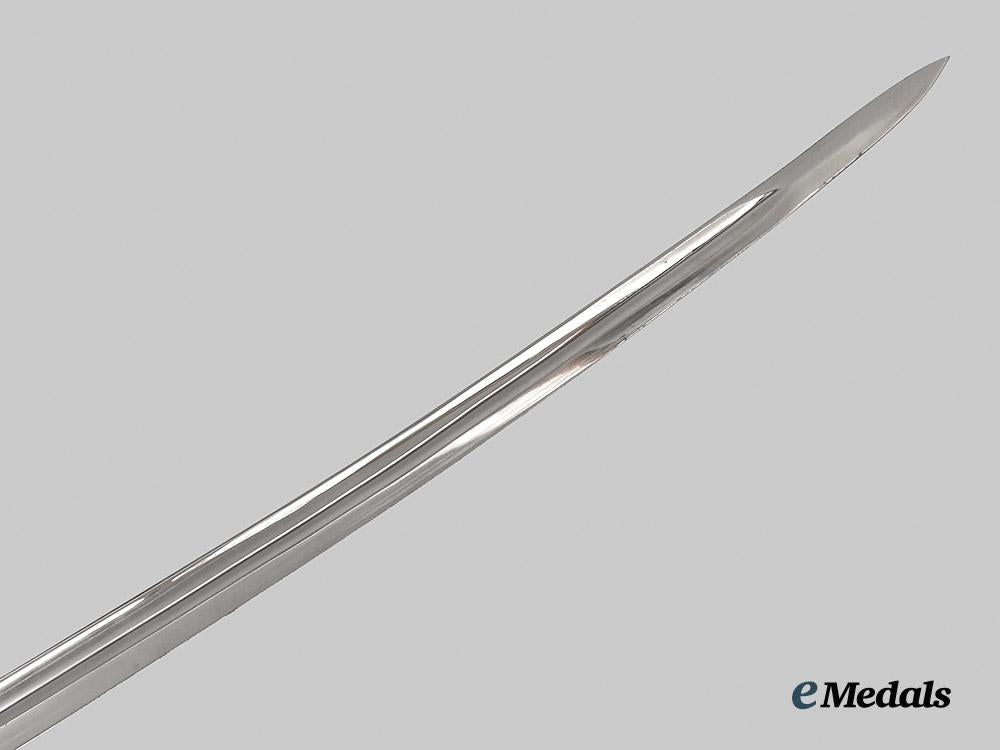
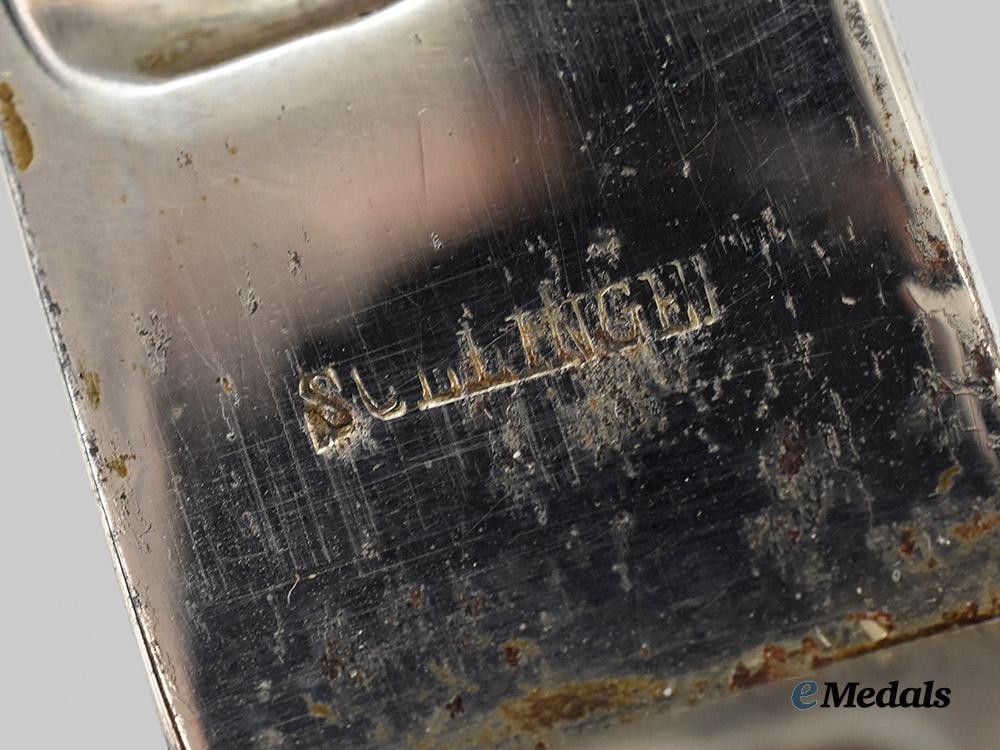
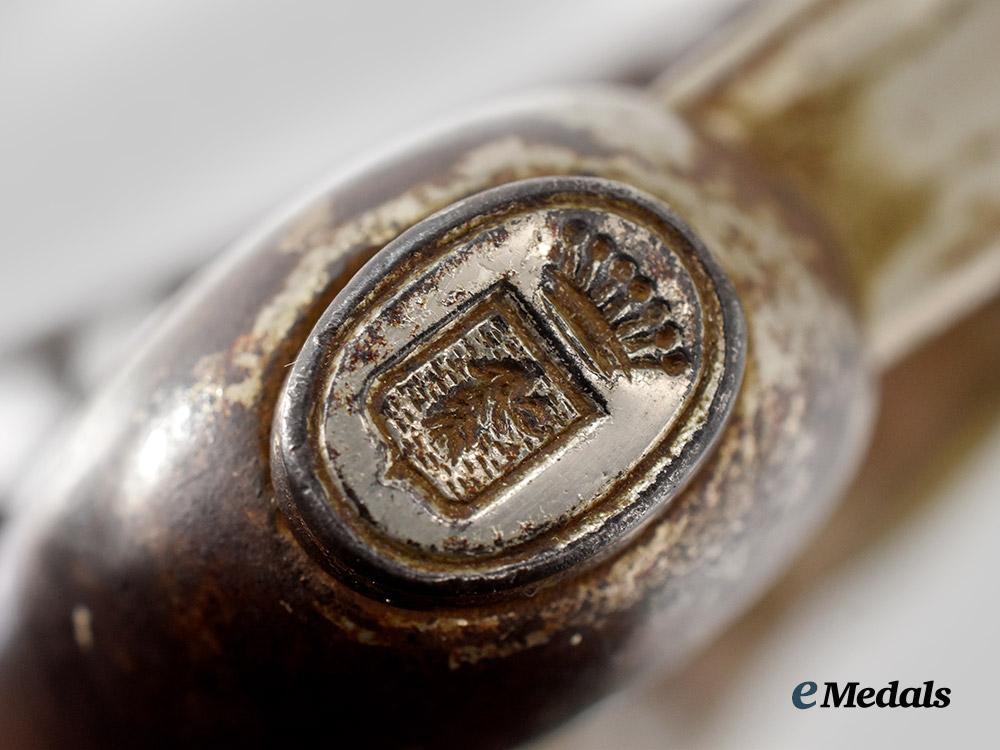
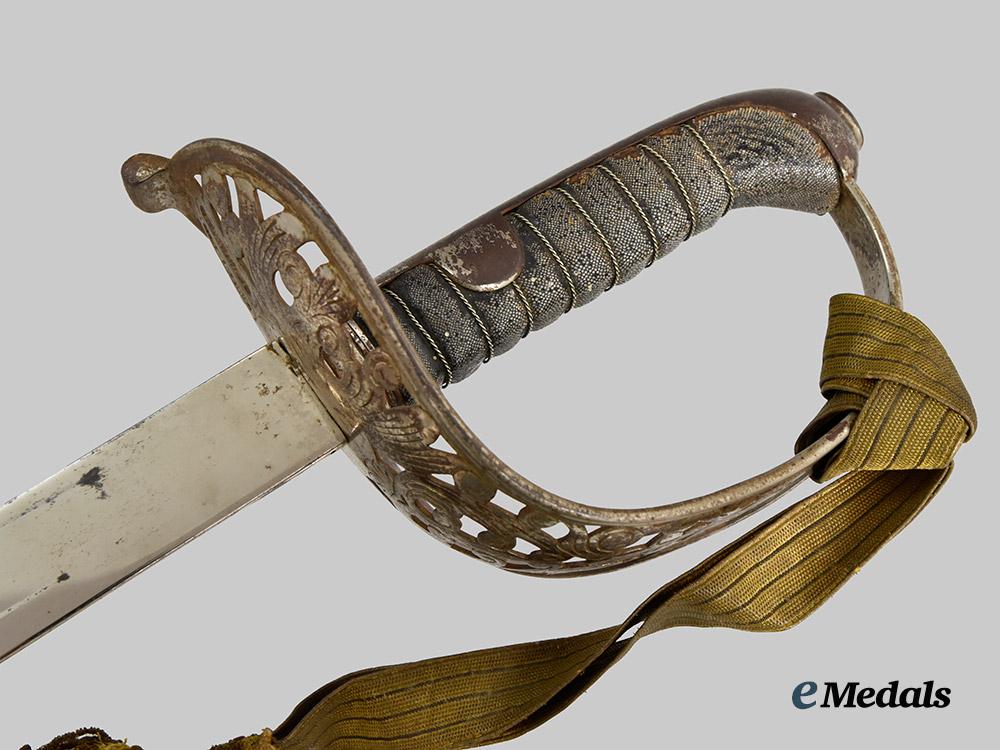
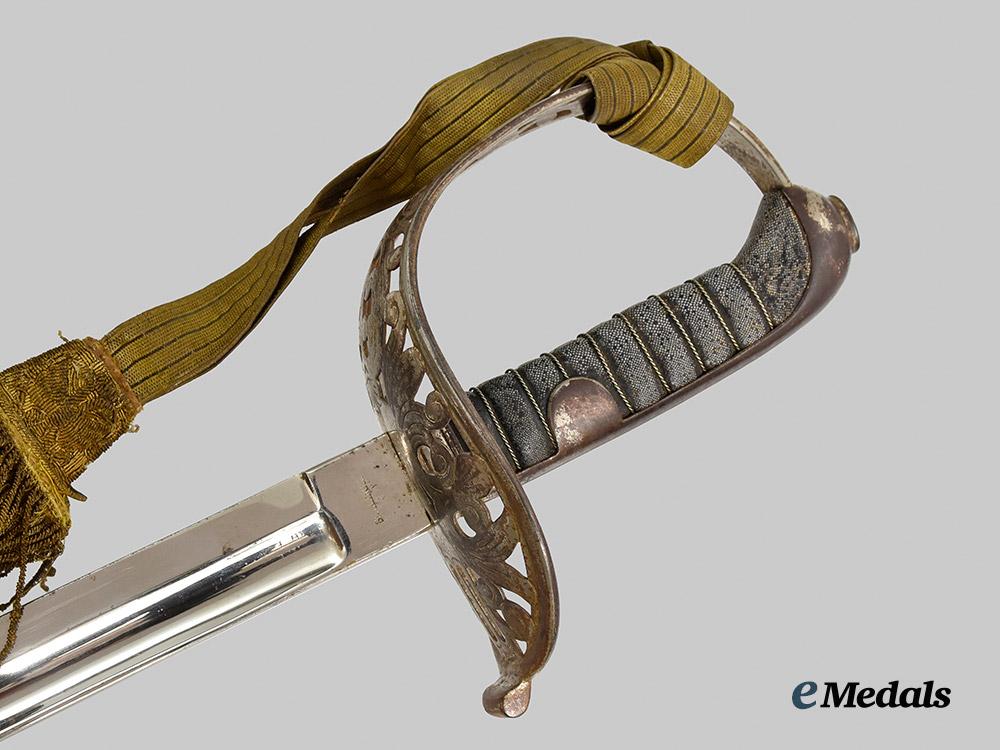
Austria, Empire. An Imperial and Royal (K.u.K.) Government Official's Sword, by Sollingen
Austria, Empire. An Imperial and Royal (K.u.K.) Government Official's Sword, by Sollingen
SKU: ITEM: EU20251
Buyer's Premium
Current Bid:
Your Max Bid:
Bid History:
Time Remaining:
Couldn't load pickup availability
Shipping Details
Shipping Details
eMedals offers rapid domestic and international shipping. Orders received prior to 12:00pm (EST) will be shipped on the same business day.* Orders placed on Canadian Federal holidays will be dispatched the subsequent business day. Courier tracking numbers are provided for all shipments. All items purchased from eMedals can be returned for a full monetary refund or merchandise credit, providing the criteria presented in our Terms & Conditions are met. *Please note that the addition of a COA may impact dispatch time.
Shipping Details
eMedals offers rapid domestic and international shipping. Orders received prior to 12:00pm (EST) will be shipped on the same business day.* Orders placed on Canadian Federal holidays will be dispatched the subsequent business day. Courier tracking numbers are provided for all shipments. All items purchased from eMedals can be returned for a full monetary refund or merchandise credit, providing the criteria presented in our Terms & Conditions are met. *Please note that the addition of a COA may impact dispatch time.
Description
Description
Sword is German-made and incorporates a magnetic nickel-plated steel blade, with a dull edge and having a very sharp tip, along with a flat spine, with the fuller running almost the full length of the sword on one side, along with being marked "SOLLINGEN" on the ricasso. The blade exhibits moderate surface wear and pitting, along with scratches overall, common to extraction and return to the scabbard, measuring 730 mm in length and is firm in the hilt. The handle and crossguard are in silvered steel and are magnetic, the latter incorporating a voided design that features an intricate pattern of ornate swirls and leafing covering the basket, with both the spine of the handle and the crossguard exhibiting silvering wear and surface rust. The grip is in a black fishskin pebbled material and wrapped in eight rows of twisted silvered wire, all of the wire intact, however it does exhibit scattered wear and chipping in the fishskin covering. Between the blade and the grip is a steel band with a series of rules around its circumference. The handle is wrapped in the appropriate style with a 22 mm wide cord in fine gold-coloured bullion wire, in a thatched-pattern and bearing three equidistant stripes in black threading. The cord is finished with a 55 mm wide x 33 mm high x 60 mm deep portepee, in rolled gold-coloured bullion wire wrapped around a wooden frame, the stem bearing the Imperial coat-of-arms of the Empire of Austria on one side, while the other side has the intricate "FJ1" imperial monogram of Empire Franz Joseph I, both insignia in a rolled copper-coloured bullion wire that contrasts with the adjoining gold-colored bullion wire background. The head features a 70 mm long rolled gold-coloured copper bullion wire fringe. One strand wrapped around the base of the stem and covering the head has begun to detach from the body, the fringe itself exhibiting traces of fraying along with scattered discoloration. The pommel is oval-shaped and features an insignia composed of a shield surmounted by a coronet, the sword measuring 880 mm in length. The accompanying scabbard is also magnetic and in silvered steel, along with the chape, central band and locket. The chape is finished in a snub-nosed style, the central band with a single suspension ring affixed, the locket with a u-shaped loop attached to its reverse, the throat incorporating a band with a wide mouth, the scabbard measuring 740 mm in length and exhibiting a few dents, along with silvering wear and surface rust. Very fine.
Footnote: The designation "K.u.K." (Kaiserlich und Königlich = Imperial and Royal) is used to refer to the Dual Monarchy of Austria-Hungary from 1867 to 1918. During that period, it indicated that the Habsburg monarch reigned simultaneously as the Kaiser (Emperor of Austria) and as the König (King of Hungary), while the two territories were joined in a real union (akin to a two-state federation in this instance). The acts of the common government, which was responsible only for the Imperial & Royal ("I&R") Ministry of Foreign Affairs, the I&R Ministry of War and the I&R Ministry of Finance (financing only the two other ministries), were carried out in the name of "His Imperial and Royal Majesty", and the central governmental bodies had their names prefixed with K.u.K.
Description
Sword is German-made and incorporates a magnetic nickel-plated steel blade, with a dull edge and having a very sharp tip, along with a flat spine, with the fuller running almost the full length of the sword on one side, along with being marked "SOLLINGEN" on the ricasso. The blade exhibits moderate surface wear and pitting, along with scratches overall, common to extraction and return to the scabbard, measuring 730 mm in length and is firm in the hilt. The handle and crossguard are in silvered steel and are magnetic, the latter incorporating a voided design that features an intricate pattern of ornate swirls and leafing covering the basket, with both the spine of the handle and the crossguard exhibiting silvering wear and surface rust. The grip is in a black fishskin pebbled material and wrapped in eight rows of twisted silvered wire, all of the wire intact, however it does exhibit scattered wear and chipping in the fishskin covering. Between the blade and the grip is a steel band with a series of rules around its circumference. The handle is wrapped in the appropriate style with a 22 mm wide cord in fine gold-coloured bullion wire, in a thatched-pattern and bearing three equidistant stripes in black threading. The cord is finished with a 55 mm wide x 33 mm high x 60 mm deep portepee, in rolled gold-coloured bullion wire wrapped around a wooden frame, the stem bearing the Imperial coat-of-arms of the Empire of Austria on one side, while the other side has the intricate "FJ1" imperial monogram of Empire Franz Joseph I, both insignia in a rolled copper-coloured bullion wire that contrasts with the adjoining gold-colored bullion wire background. The head features a 70 mm long rolled gold-coloured copper bullion wire fringe. One strand wrapped around the base of the stem and covering the head has begun to detach from the body, the fringe itself exhibiting traces of fraying along with scattered discoloration. The pommel is oval-shaped and features an insignia composed of a shield surmounted by a coronet, the sword measuring 880 mm in length. The accompanying scabbard is also magnetic and in silvered steel, along with the chape, central band and locket. The chape is finished in a snub-nosed style, the central band with a single suspension ring affixed, the locket with a u-shaped loop attached to its reverse, the throat incorporating a band with a wide mouth, the scabbard measuring 740 mm in length and exhibiting a few dents, along with silvering wear and surface rust. Very fine.
Footnote: The designation "K.u.K." (Kaiserlich und Königlich = Imperial and Royal) is used to refer to the Dual Monarchy of Austria-Hungary from 1867 to 1918. During that period, it indicated that the Habsburg monarch reigned simultaneously as the Kaiser (Emperor of Austria) and as the König (King of Hungary), while the two territories were joined in a real union (akin to a two-state federation in this instance). The acts of the common government, which was responsible only for the Imperial & Royal ("I&R") Ministry of Foreign Affairs, the I&R Ministry of War and the I&R Ministry of Finance (financing only the two other ministries), were carried out in the name of "His Imperial and Royal Majesty", and the central governmental bodies had their names prefixed with K.u.K.
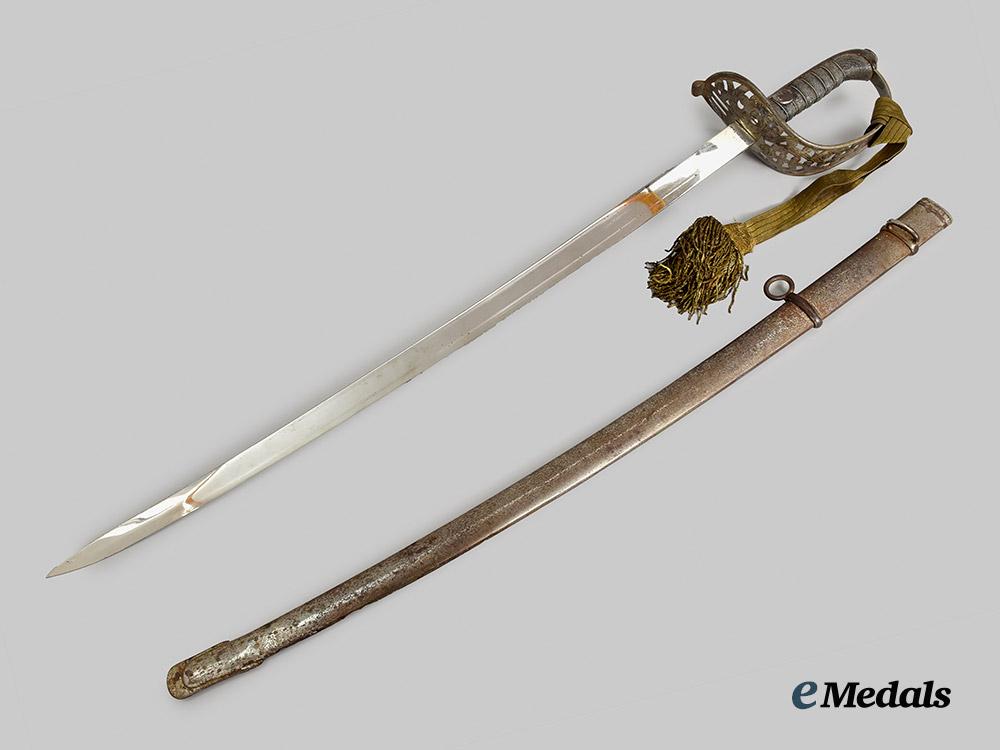
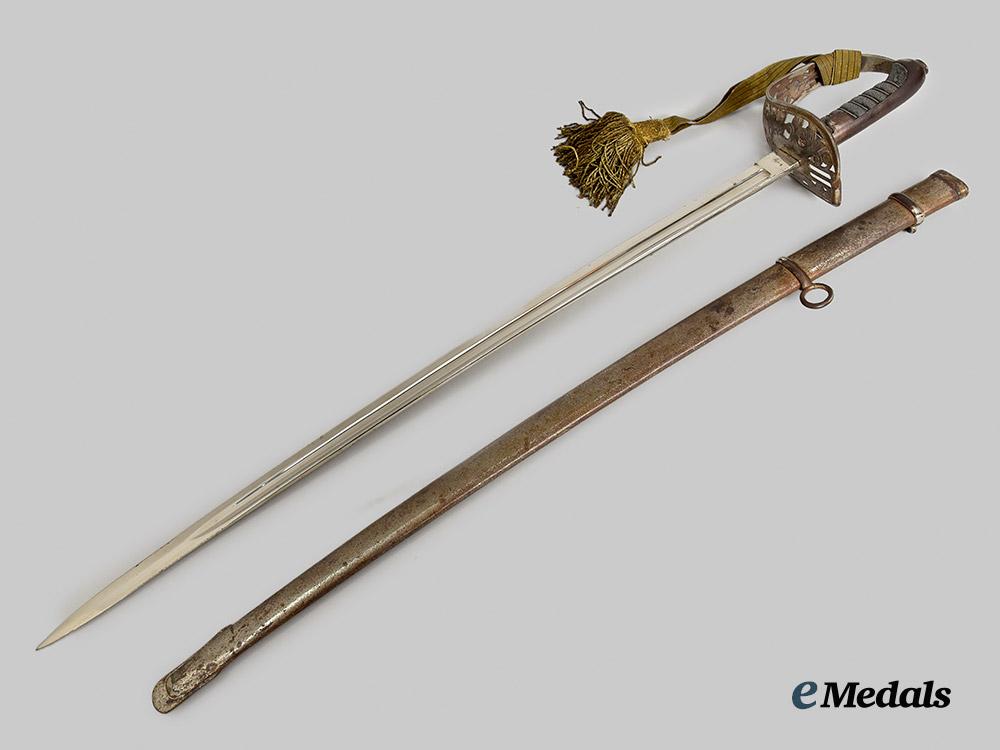
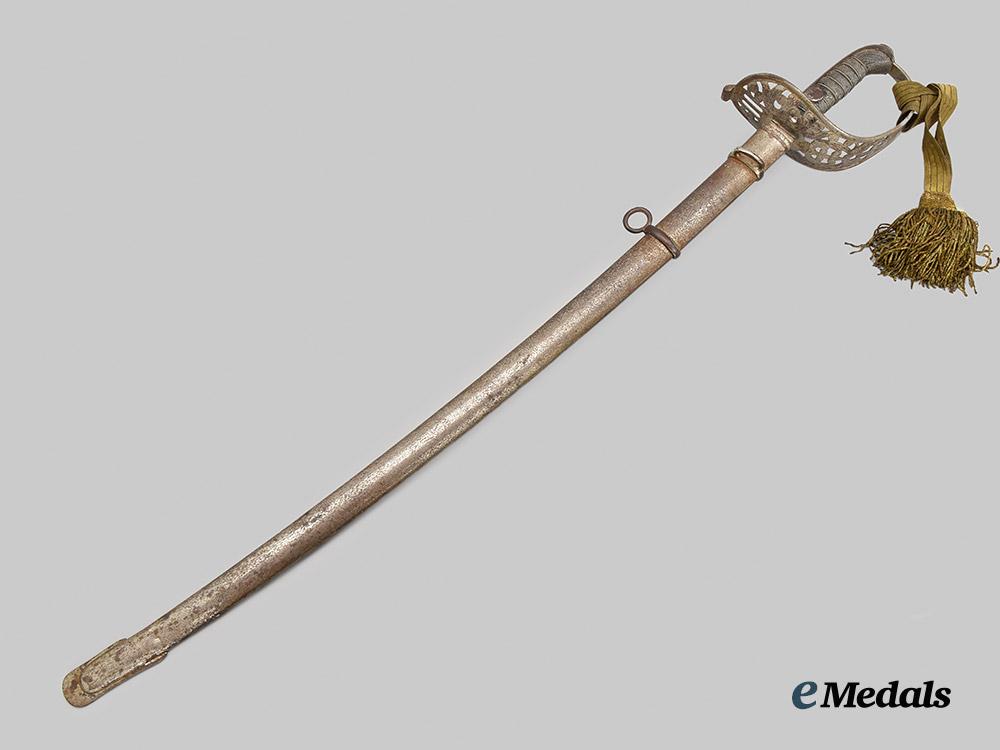
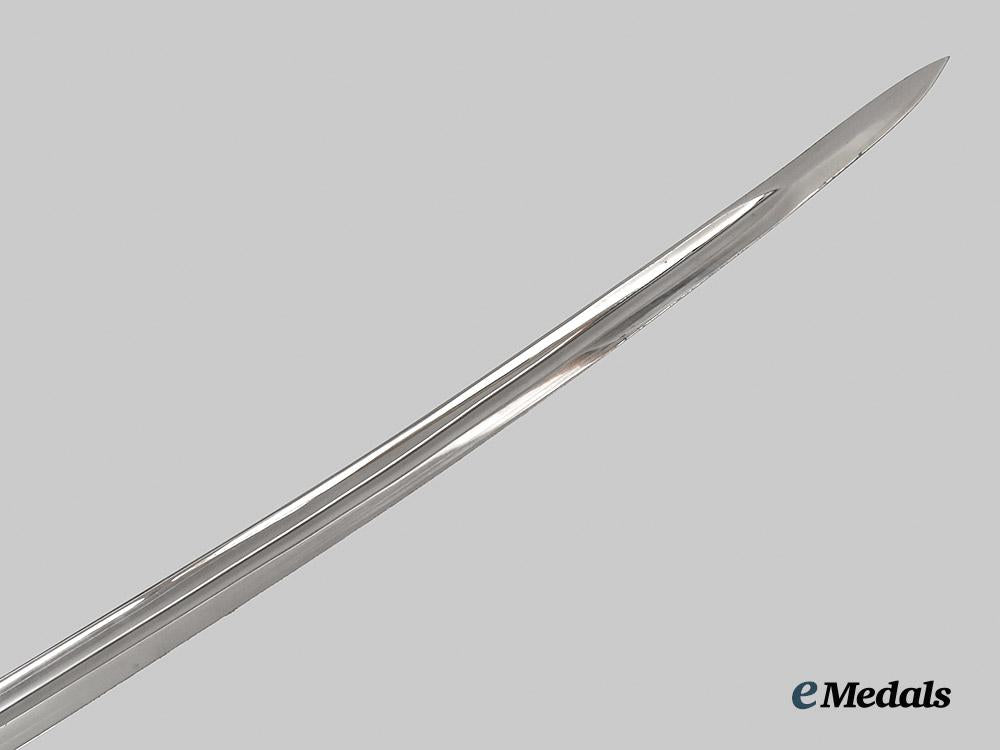
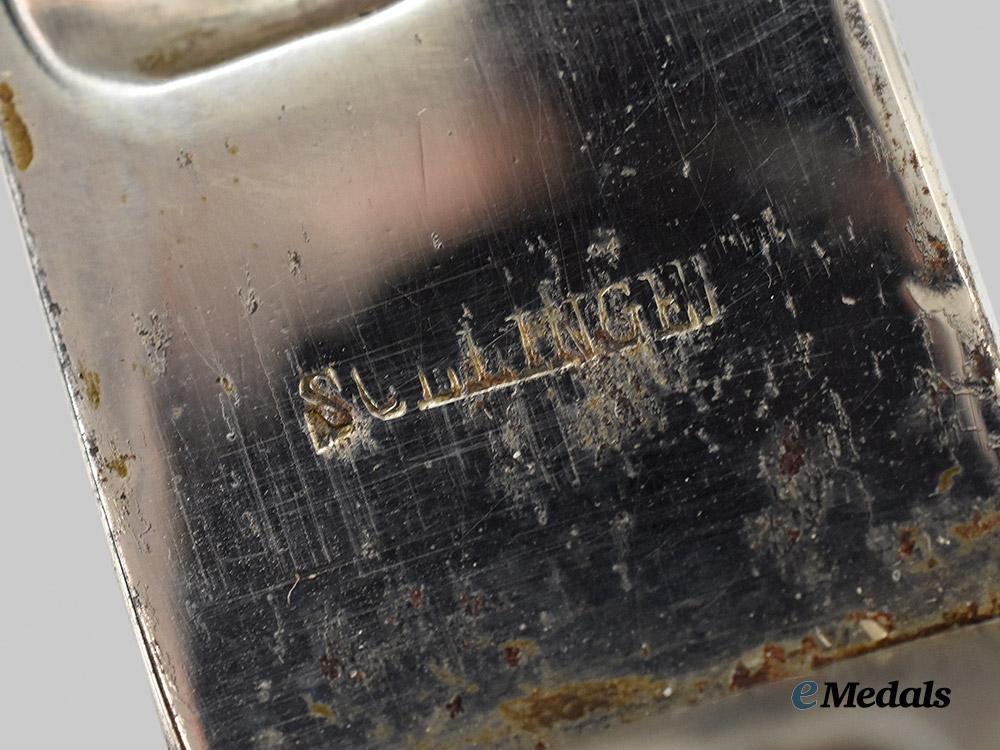
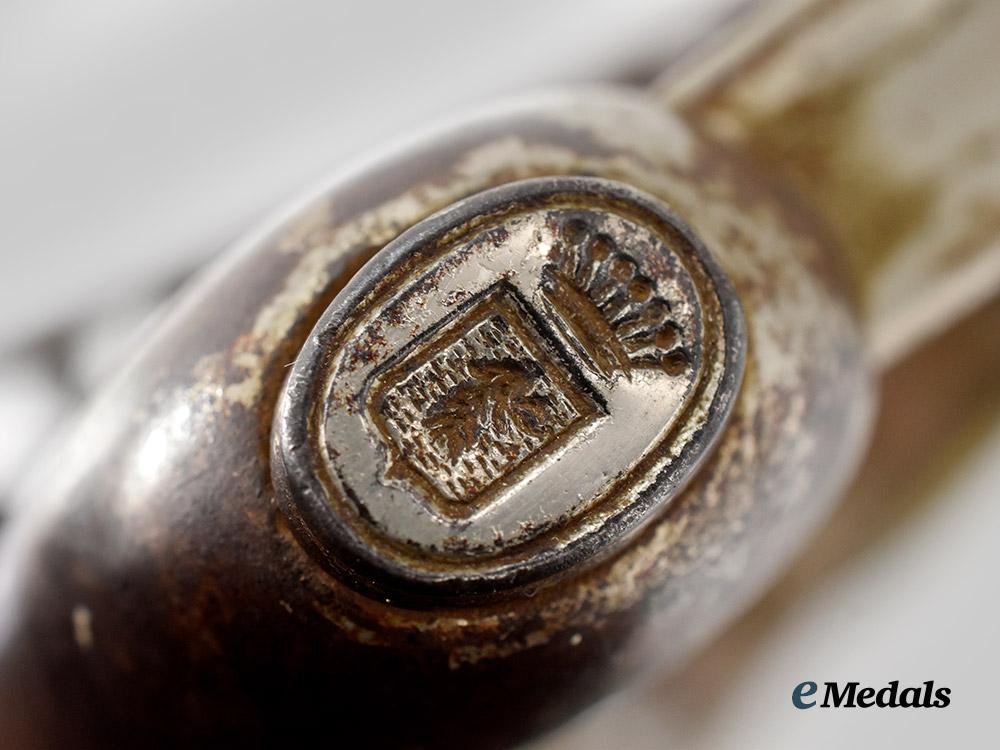
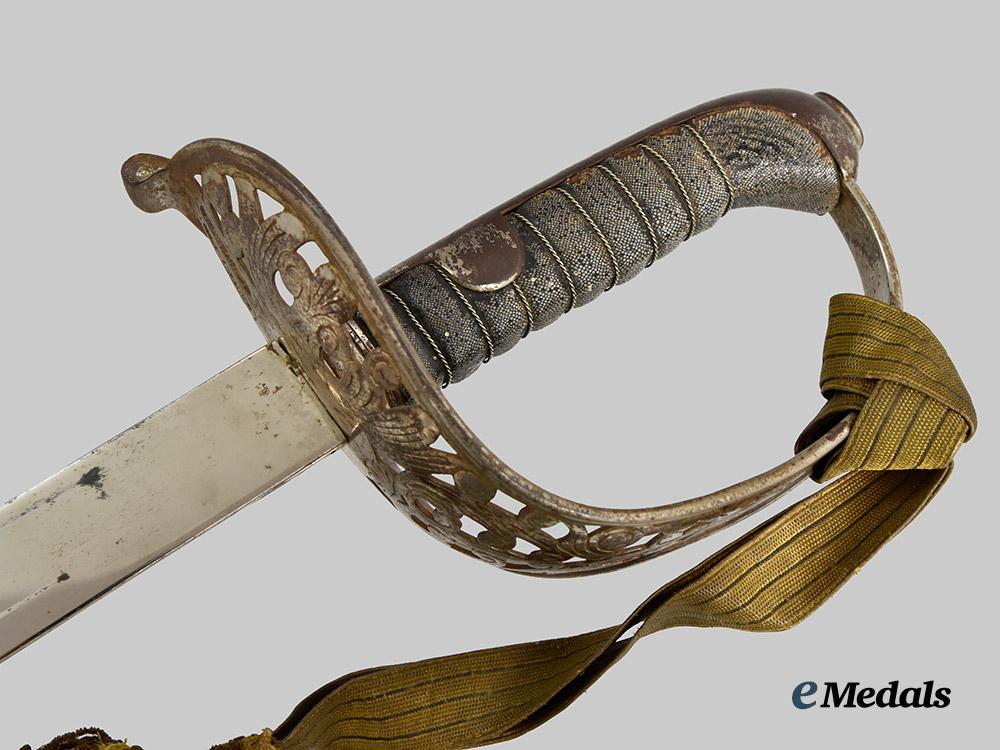
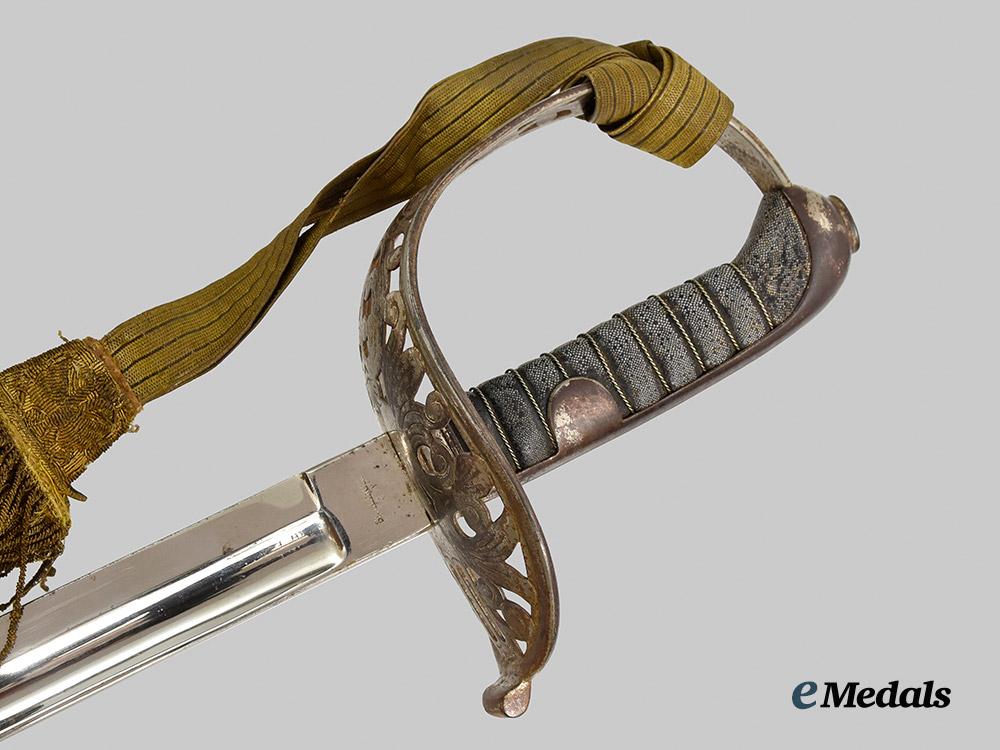
You May Also Like
Japan, Manchuko Period. An Order of the Pillars of the State, VIII Class
W7374
Italy, Kingdom. An Order of the Crown, Commander in Gold, c.1900
EU23416
Germany, Imperial. A Husaren-Regiment König Wilhelm I Nr 7. Officer’s M89 Sword
G59104
Germany, Luftwaffe. A Mint Geschwader Hindenburg EM/NCO’s Cuff Title
G59145
Germany, Luftwaffe. A 1st Fallschirm-Panzer Division Hermann Göring Leutnant Collar Tab
G59122
-
Japan, Manchuko Period. An Order of the Pillars of the State, VIII Class
W7374
Add to CartRegular price $400 USDRegular price $0 USD Sale price $400 USDUnit price / per -
Italy, Kingdom. An Order of the Crown, Commander in Gold, c.1900
EU23416
Add to CartRegular price $400 USDRegular price $0 USD Sale price $400 USDUnit price / per -
Germany, Imperial. A Husaren-Regiment König Wilhelm I Nr 7. Officer’s M89 Sword
G59104
Add to CartRegular price $685 USDRegular price $0 USD Sale price $685 USDUnit price / per -
Germany, Luftwaffe. A Mint Geschwader Hindenburg EM/NCO’s Cuff Title
G59145
Add to CartRegular price $230 USDRegular price $0 USD Sale price $230 USDUnit price / per -
Germany, Luftwaffe. A 1st Fallschirm-Panzer Division Hermann Göring Leutnant Collar Tab
G59122
Add to CartRegular price $135 USDRegular price $0 USD Sale price $135 USDUnit price / per
Do you have a similar item you are interested in selling?
Please complete the form and our client care representatives will contact you.
Sell Item